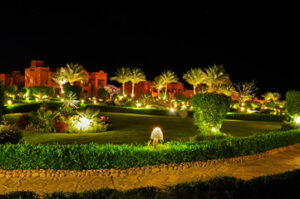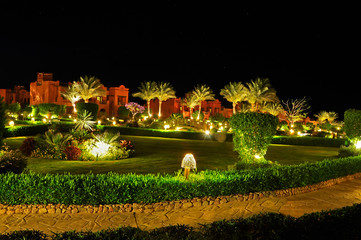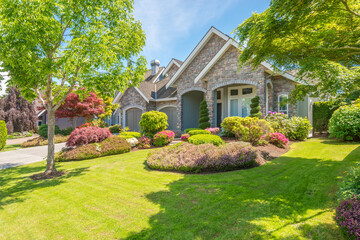Landscape lighting changes the entire mood of an outdoor space. It turns dark corners into visual highlights. It reveals textures that vanish in daylight. It creates calm, drama, or mystery depending on the light’s intent.
Modern landscape lighting goes beyond visibility. It has become a form of spatial storytelling. Light can guide, invite, or even repel. Outdoor design now includes narrative, not just decoration. Contact Elegant Custom Images Inc for professional help.
One emerging trend is dynamic intensity. Lights that shift brightness throughout the evening mimic natural rhythms. It’s gentler on the eyes and complements changing activities. A dinner needs more glow than a midnight stroll.
Some systems use movement tracking. When someone enters the garden, the lights brighten subtly. When no one’s around, they dim or turn off. This minimizes energy use and enhances safety.
Color temperature control is gaining attention. Warm lighting encourages intimacy, while cool tones suggest clarity. Some designers now blend both in a single space. Transitions feel seamless and sophisticated.
Directional lighting has taken a new turn. Fixtures can now adjust their aim through automation. This allows one setup to support multiple functions. It’s like having a lighting assistant outdoors.
Underground fiber optic systems are making waves. These use tiny strands to carry light without heat. It means lights can be embedded directly in soil or stone. Safety and style blend without compromise.
Another innovation is programmable lighting zones. You can create themes for different days or events. Some areas glow with softness while others burst with color. The yard becomes responsive and versatile.
Bioluminescent elements are entering the scene. Materials that glow naturally are added to pathways or ponds. They require no electricity and offer a surreal glow. It turns gardens into otherworldly experiences.
Tree-mounted systems are now discreet and effective. They hide within branches, casting downward patterns like moonlight. These shadows feel organic and alive. Guests often wonder where the light is coming from.
Moisture-reactive lighting is gaining interest. These systems glow differently after rain or during high humidity. It gives an ethereal shimmer to wet leaves or stone. Weather becomes part of the light show.
More homeowners are asking for meditative zones. These areas use low, flickering lighting that mimics candles or fireflies. It’s designed to calm the senses. Nature and light work together to soothe the mind.
Invisible lighting is also growing in popularity. Fixtures are buried or disguised within the landscape. The effect is pure light without the distraction of hardware. The magic feels effortless and intentional.
Light-responsive flora is a cutting-edge feature. Certain plants are bred or treated to reflect light more intensely. They shimmer when lit and fade when not. Gardens become responsive and ever-changing.
Some lighting now reacts to sound. Wind chimes or music trigger subtle shifts in color or brightness. This enhances the mood based on interaction. It’s a gentle fusion of the senses.
In-ground lenses are replacing traditional stake lights. These give a polished, architectural feel. Light appears to emerge from the earth itself. It turns pathways into glowing rivers of light.
Vertical lighting is gaining ground too. Poles with upward-facing light highlight walls or climbing plants. It creates drama without harsh glare. Shadows stretch higher, making gardens feel taller at night.
Custom-designed light patterns are now possible. Fixtures cast shapes like leaves, waves, or geometric lines. These patterns shift based on angle and viewer position. Every walk outside becomes an art installation.
Energy harvesting systems are being explored. These include solar, kinetic, or even thermal energy sources. It removes the need for traditional wiring. Nature powers the glow that honors it.
Touch-sensitive lighting zones bring new interactivity. Pressing a stone or touching a leaf triggers illumination. This is popular in playful or child-focused spaces. Lighting becomes part of the landscape’s personality.
Invisible borders are created using linear LED strips. These are placed under steps, benches, or railings. They define space without walls or fences. Light guides behavior subtly and beautifully.
Seasonal transformation is another fresh idea. Lighting scenes change automatically with the calendar. Spring shows pastel glows, while autumn uses amber tones. It mirrors the emotional shift of each season.
Materials now play a bigger role in how light behaves. Rough stone diffuses light softly, while glass tiles reflect sharp glows. Designers use this to control ambiance. The texture becomes the light’s partner.
Floating light spheres are becoming statement pieces. They drift in pools or ponds, casting ripples of glow. Their movement catches the eye and invites stillness. It adds elegance to any water feature.
Low-angle grazing lights create a tactile effect. They highlight the smallest bumps and ridges in stone or bark. Even familiar surfaces seem new at night. Texture becomes theater under these beams.
Subtle edge lighting is reshaping outdoor seating. Benches now glow underneath or behind. This makes them stand out while staying visually soft. Gathering areas feel more intentional and inviting.
Digital controls now offer scene memory. Users save light layouts for recurring moments. Whether it’s a quiet tea or an outdoor movie, the setting is just a tap away. Lighting adapts to habits and lifestyles.
There is a growing demand for glare-free fixtures. These use shielded bulbs and angled reflectors. Light is directed only where needed. It’s better for guests, wildlife, and neighbors.
Smart integration is reaching new levels. Voice commands can trigger lighting effects. Weather apps can pre-set light for cloudy evenings. Outdoor tech is finally catching up to indoor smart home systems.
Responsive sculpture lighting is an artistic blend. Metallic garden sculptures now include internal LEDs. As wind or sound moves them, light patterns shift. Art and lighting merge into one breathing entity.
Remote diagnostics are also being added. Systems notify owners when a bulb is failing or needs cleaning. This saves time and keeps the display flawless. Outdoor maintenance becomes less of a chore.
Some designers explore chromotherapy-inspired setups. These use colors tied to emotions or mental states. The light isn’t just decorative—it’s therapeutic. Mood-based lighting is the future of personal outdoor space.
Projection lighting is being revived with a modern twist. Rather than static beams, designers use projectors for motion effects. Leaves seem to dance or water appears to ripple. The space feels alive and theatrical.
Voice-guided lighting design is a unique offering. Users describe what they feel or want, and AI suggests settings. It makes customization easier for non-designers. Your outdoor space learns your mood in real-time.
Photoluminescent paths are being paired with low-voltage lighting. They store energy by day and softly glow at night. This doubles visibility and adds a dreamy vibe. Even without power, beauty stays on.
Rain-sensing dimmers are also new to the market. These lower brightness during storms or wet nights. It prevents glare on slick surfaces. It also respects the calm nature of rainy weather.
Minimalist micro-lights are taking over cluttered designs. These are barely visible during the day. At night, they create pinpoint stars across gardens. The effect is elegant and cosmic.
Organic path lighting avoids symmetry altogether. Lights are placed based on plant growth and stone flow. This creates a natural walking rhythm. It feels intuitive rather than staged.
Layered lighting is also coming into focus. One layer may highlight plants, another highlights structures. A third adds background glow. These layers add depth and dimension, making a flat garden feel expansive.
Curved light rails are emerging in modern outdoor architecture. They wrap around trees, decks, or curved benches. The light flows like water instead of standing still. It mimics movement even in stillness.
Augmented lighting elements are gaining traction. With mobile apps, visitors can see virtual labels or effects. Lighting becomes part of an interactive tour. Education and aesthetics blend beautifully.
The idea of eco-empathy lighting is gaining strength. These setups minimize disruption to local wildlife. Light colors and timing are selected for harmony. It respects the natural rhythms of the space.
Some systems now mimic fireflies or natural glow-bugs. Random flickers across the garden add whimsy and realism. It brings a touch of childhood wonder to adult design. Artificial lighting feels magically organic.
Underwater lighting has become more refined. Color-changing options now work even in shallow or flowing water. Ponds and fountains glow like crystals. Light moves with the water, never against it.
Soft perimeter lighting defines boundaries without feeling harsh. These are useful for gardens without fences. Light creates a sense of privacy. It feels open yet personal.
Reclaimed materials are being used in light fixtures. Old metal, glass, or wood is repurposed to hold new LEDs. It adds soul and history to modern tech. The past and future meet under one beam.
Cloud-controlled landscape lighting is also on the rise. No matter where you are, settings can be updated. Homeowners on vacation still maintain control. Peace of mind extends outdoors.
The final frontier lies in emotional lighting AI. Systems detect your voice tone or facial expressions. They change lighting to match your energy. Outdoor light becomes as intuitive as human emotion.
Landscape lighting is no longer about avoiding darkness. It’s about expressing personality, enhancing wellness, and respecting nature. The right glow does more than show—it tells stories. The night, when thoughtfully lit, becomes a living canvas.


